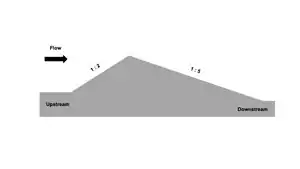Crump weir
The Crump weir was designed by and is named for Edwin Samuel Crump, English civil engineer specialising in hydraulics.[1] A Crump weir is a two dimensional triangular weir with a horizontal crest in the transverse direction and a triangular crest shape in the stream-wise direction. The upstream slope is 1 (vertical) in 2 (horizontal) and the downstream slope is from 1:5 to 1:2.[2] The intersection of the two sloping surfaces forms a straight horizontal crest at right angles to the flow direction in the approach flow channel. The crest may either be made of carefully aligned and joined concrete sections, or have a cast-in non-corrodible metal profile. Crump weirs are used as measuring structures in open channels. They have the advantage that the coefficient of discharge is predictable and that the downstream bed elevations have little effect on modular limits and modular coefficient, for one in two upstream and one in five downstream sloping faces.
 | |
| Product family | Weirs |
|---|---|
References
- Anonymous (1972). Edwin Samuel Crump, Who Was Who. London: Black. p. 263.
- Crump, E.S. (1952). "A new method of gauging stream flow with little afflux by means of a submerged weir of triangular profile". Proc Institution of Civil Engineers. 1: 749–767.